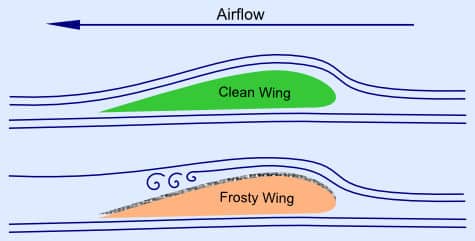
In our Ask a Pilot series, pilot Spencer Marker answers one of your aviation-related questions each week. See past installments here and submit your own to Whitney@johnnyjet.com.
The question
Hey Spencer, I noticed on my flight a few weeks ago that the pilots deiced the airplane with only a tiny amount of frost on the wing. It caused us to be a little late landing. My question is why they needed to remove such a tiny amount of ice. Thanks!
—Chris W.
The answer
Hey Chris, thanks for writing in this week and allowing me to explain a few things about how pilots manage their work during colder months. Given the weather last week, I’m sure I’ll be receiving a few more questions about it!
When the temperatures start to drop, pilots must always be on alert for the presence of frozen contaminates (ice and snow) adhering to the aircraft. The FAA and the airlines require pilots to remove, either by manual means (brushing) or by liquid deicing, any ice or snow that may be adhering to the aircraft. This includes even tiny amounts of frost. But why are the airlines and the FAA so strict about this? Let’s take a look at how snow and ice affect an aircraft’s performance and what we do about it.
Snow and ice
When the white stuff starts falling from the sky, airlines, pilots and ground crews turn their attention to assuring their aircraft are free from any frozen contaminants. These include snow, ice, sleet, and even frost. Pilots are indoctrinated in what the airlines refer to as a “Clean Aircraft Concept.” This means that anytime ice is adhered to the aircraft, it must be removed. Sometimes this means removing the snow manually using brushes (only works with dry snow) or by using deicing fluid.

So why the abundance of caution when it comes to removing snow and ice? Won’t it just blow off? That’s a good question. Sometimes the snow and ice will blow off, but that’s not always a good thing. You see, when ice adheres to an airplane, a couple things happen. First, ice resting on an airplane’s wing can alter its shape. As we know, the shape, or airfoil, is vitally important to the creation of lift. Adding ice or snow changes this shape, leading to unpredictable flying characteristics. Ice is also heavy, and can add additional unplanned weight to the aircraft. And while the snow and ice could blow off, just like a car on the freeway, it can come off in large pieces, potentially causing damage. It’s really best to just remove it.
So that brings me to the heart of your question: Why does even a tiny amount of frost need to be removed? The answer lies in how frost affects an airplane’s ability to make lift. Airplanes rely on the smooth flow of air over a wing in order to ensure the proper amount of lift is created. Unlike a large accumulation of ice, frost doesn’t drastically alter the shape of the wing. However, when frost is adhering to the wing, the surface becomes rough like sandpaper, and the airflow is no longer able to glide smoothly over the wing. This creates turbulent flow, which degrades a wing’s ability to make lift. The resulting loss of lift can mean a higher stall speed, unpredictable aircraft performance, or the inability to fly at all. So on clear, humid and cold mornings, pilots are extra vigilant in dealing with the buildup of frost on their aircraft. If they see it, they remove it. Simple as that.

To sum up
Thanks for the question this week, Chris. When the weather turns cold, your flight crews become extra vigilant in ensuring no snow or ice is sticking to the airplane. And while the delay incurred while visiting the deice pad may be annoying, removing even small amounts of ice is of paramount importance. After all, it’s our job above all else to make sure you get to your destination safely. And that’s a responsibly we don’t take lightly.
Do you have a story of flying in winter weather? Post in the comments below. And if anyone has a burning aviation question or something you would like cleared up, drop us a line at Whitney@johnnyjet.com to get your question featured in an upcoming Ask a Pilot column.
Tailwinds,
—Spencer








Nice article and well said. We have the same policy at our airline where if theres any ice or frost on top of the wing, we need to remove it no matter what the current weather is. The bottom of the wing we are afforded up to 3mm of hoar frost which is common to form during refuelling.
Hey Dan. That’s exactly right and a great point! Thank you for including this. The airline’s I’ve worked for have the same policy regarding frost on the underside of the wing after a flight where the cold leftover fuel sits at the bottom of the tank. I sincerely appreciate your comment and thanks for reading!